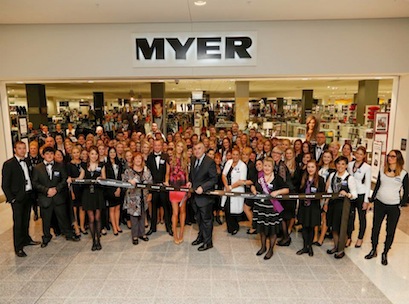Last week, Myer debuted its Autumn/Winter collection in the University of Melbourne’s heritage-listed underground carpark. Although the moodily-lit, red-carpet-lined cavern had space for just 120 guests, the retailer gave more than 100,000 people front row views of the catwalk. How was this possible? Live video. Myer is the first department store chain in the world and the first Australian brand ever to use Periscope, Twitter’s new video feature. Launched in December of last year, Periscope
allows users to broadcast live video content directly in the Twitter app. It differentiates from Facebook Live and other social video platforms by letting users change the perspective to gain a full 360-degree view of the filmmaker’s surroundings.
Mike Scott, Myer’s executive general manager of marketing and brand, says the decision to team up with Twitter and Periscope was intended to inject a sense of excitement and theatre into Myer’s offering, an approach that has seen the retailer form partnerships with Tesla, UberEATS and RedBalloon recently.
“We’re a year-and-a-half into our five-year transformation plan, and one of our key strategic thrusts is putting consumers right at the heart of everything we do. As much as we are using technology to do this, it always goes back to customer-centricity and delivering more and more benefits,” Scott explained to IRW.
One way Myer does this is by breaking down traditional ideas of who has the opportunity to attend fashion shows. The retailer is at the forefront of this democratisation process, opening up its shows beyond the typical audience of magazine editors, celebrities and fashion bloggers to include its own customers.
“About half the audience who attended our Spring/Summer fashion launch last year were actual customers,” Scott said.
The recent Periscope video, which Twitter users could watch live or replay, is another example of this process on a massive scale. Produced by a team of 15 in-house and agency people, the video received over 100,000 views and 30,000 ‘hearts’ on Twitter within 12 hours of its release.
As a customer-centric marketing initiative, it was enormously successful. According to Scott, it’s also an indication of the way Myer intends to reach consumers going forward.
“We are competing on a world stage now. Supply chains are being reduced in length, and that requires us to compete with the best of the best. We need to be partnering with the likes of Google, Twitter and Facebook to be on the cutting edge,” he said.
Coming to a small screen near you
Myer’s Periscope debut is just the latest example of retailers’ growing enthusiasm for producing live, social and/or shoppable video content. One of the biggest draws is the size of the audience.
A recent report from Reuters predicts video will make up 70 per cent of mobile traffic by 2021. Already, Australians spend an average of one hour per month watching video on their smartphones, according to the Interactive Advertising Bureau.
It’s not surprising that retailers are turning to the format in their quest to be where their customers are. But many retailers are now finding the immersive and narrative quality of video has its own appeal.
Jane Lu, founder and CEO of online fashion store Showpo, says it does a better job of communicating her brand than any other medium.
“Our company has a lot of personality and it’s something our customers really align with. We can portray this much better in video,” Lu told IRW.
Admittedly, Showpo’s customers are mostly 20-something women, a demographic already active on social media. But Lu says the video format is also well-suited to her product category.
“Video is a great place to launch a fashion product or brand because you can share the back story. Customers also prefer to see clothes in motion, since it gives them a better sense of how it fits,” she said.
Showpo currently publishes video content through Instagram, Snapchat and Facebook. The retailer has no plans to use Periscope. And compared to Myer’s 15-person production team, Showpo takes a more casual approach to shooting content.
“We just approach it as a consumer would. Because it’s new, we just wing it and learn as we go,” Lu said.
Hardware chain goes to Hollywood
But producing social media video content doesn’t only make sense for fashion retailers or youth-oriented brands. In fact, Mitre 10 in New Zealand was an early adopter in this space.
Dave Elliott, Mitre 10 New Zealand’s general manager of marketing, told IRW that the hardware store chain has been uploading video content on YouTube for around four years.
“When we kicked off, we were getting around 15,000 views per week. Now we’re getting around 150,000 views per week,” Elliott said.
In August last year, Mitre 10 NZ took the next step by launching its own shoppable video channel. Mitre 10 On Demand features well over a hundred DIY tutorials, how-tos and room renovation reveals, with integrated links to featured products.
“We believe this is the platform of the future for us, as we roll out a loyalty play, a customised play and the fact that it’s integrated with our SAP Hybris e-commerce website,” Elliott said.
“What you see at the moment is just the beginning.”
Access exclusive analysis, locked news and reports with Inside Retail Weekly. Subscribe today and get our premium print publication delivered to your door every week.

